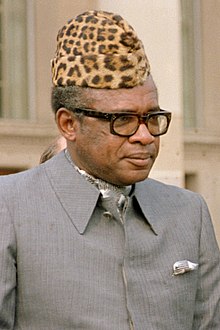Third Position
This article needs additional citations for verification. (January 2008) |
| Part of a series on |
| Neo-fascism |
|---|
|
|
The Third Position is a set of neo-fascist political ideologies that first described about in Western Europe following the Second World War. Developed in the context of the Cold War, it developed its name through the claim that it represented a third position between the capitalism of the Western Bloc and the communism of the Eastern Bloc.
Between the 1920s and 1940s, various dissident groups presented themselves as part of a movement distinct from both capitalism and Marxist socialism. This idea was revived by various political groups following the Second World War. The rhetoric of the "Third Position" developed among Terza Posizione in Italy and Troisième Voie in France; in the 1980s, it was taken up by the National Front in the United Kingdom. These groups emphasize opposition to both communism and capitalism. Advocates of Third Position politics typically present themselves as "beyond left and right" while syncretizing ideas from each end of the political spectrum, usually reactionary right-wing cultural views and radical left-wing economic views.[1][2][3][4][5][6][7]
History[]
This section does not cite any sources. (June 2018) |
The term "Third Position" was coined in Europe and the main precursors of Third Position politics were Italian fascism, Prussian socialism, National Bolshevism (a synthesis of far-right ultranationalism and far-left Bolshevism) and Strasserism (a radical, mass-action, worker-based, socialist form of Nazism, advocated by the "left-wing" of the Nazi Party by brothers Otto and Gregor Strasser, until it was crushed in the Night of the Long Knives in 1934). Neo-fascist, neo-Nazi author Francis Parker Yockey had proposed an alliance between communists and fascists called Red-Brown Alliance (Red being the color of communism and Brown being the color of Nazism) which would have been anti-Semitic, anti-American, and anti-Zionist in nature. Yockey lent support to Third World liberation movements as well.
Germany[]
Querfront ("cross-front") was the cooperation between conservative revolutionaries in Germany with the far-left during the Weimar Republic of the 1920s. The term is also used today for mutual entryism or cooperation between left and right-wing groups.
On the left, the Communists social fascism strategy focused against the Social Democrats, resulting in a stalemate and incidents of temporary cooperation with genuine fascist and ultranationalist forces.
Ernst Niekisch and others tried to combine communist and anti-capitalist nationalist forces to overthrow the existing order of the Weimar Republic. He called this merger "National Bolshevism".
The Chancellor, General Kurt von Schleicher, pursued a strategy of demerging the left (Strasserist) wing of the Nazi Party as a way of gaining Adolf Hitler's support for his government.[8] Schleicher's idea was to threaten the merger of the left-leaning Nazis and the trade unions as way of forcing Hitler to support his government, but his plan failed.[9]
France[]
This section needs additional citations for verification. (July 2020) |
During the 1930s and 1940s, a number of splinter groups from the radical left became associated with radical nationalism. Jacques Doriot's French Popular Party (from the French Communist Party) and Marcel Déat's National Popular Rally (from the French Section of the Workers' International). Third Position ideology gained some support in France, where in 1985 Jean-Gilles Malliarakis set up a "Third Way" political party, Troisième Voie (TV). Considering its main enemies to be the United States, communism and Zionism, the group advocated radical paths to national revolution. Associated for a time with the Groupe Union Défense, TV was generally on poor terms with Front National until 1991, when Malliarakis decided to approach them. As a result, TV fell apart and a radical splinter group under Christian Bouchet, Nouvelle Résistance, adopted National Bolshevik and then Eurasianist views. [10]
Italy[]
This section does not cite any sources. (June 2018) |
In Italy, the Third Position was developed by Roberto Fiore, along with Gabriele Adinolfi and , in the tradition of Italian neo-fascism. Third Position's ideology is characterized by a militarist formulation, a palingenetic ultranationalism looking favourably to national liberation movements, support for racial separatism and the adherence to a soldier lifestyle. In order to construct a cultural background for the ideology, Fiore looked to the ruralism of Julius Evola and sought to combine it with the desire for a cultural-spiritual revolution. He adopted some of the positions of the contemporary far-right, notably the ethnopluralism of Alain de Benoist and the Europe-wide appeal associated with such views as the Europe a Nation campaign of Oswald Mosley (amongst others). Fiore was one of the founders of the Terza Posizione movement in 1978. Third Position ideas are now represented in Italy by Forza Nuova, led by Fiore; and by the movement CasaPound, a network of far-right social centres.
United Kingdom[]
In the 1980s, the National Front, a British fascist party that had experienced the height of its success in the 1970s, was taken over by a Strasserist faction that referred to themselves as Third Positionist.[11] The Strasserist-led National Front was also characterised by Baker as National Bolshevist in ideology.[12] Reflecting the Nouvelle Droite's influence,[13] the Strasserist Official NF promoted support for "a broad front of racialists of all colours" who were seeking an end to multi-racial society and capitalism,[11] praising black nationalists like Louis Farrakhan and Marcus Garvey.[14] Their publication, Nationalism Today, featured positive articles on the governments of Libya and Iran, presenting them as part of a global anti-capitalist and anti-Marxist third force in international politics;[15] its members openly acknowledged the influence of Libyan leader Muammar Gaddafi and his Third International Theory.[16] This may have had tactical as well as ideological motivations, with Libya and Iran viewed as potential sources of funding.[13] This new rhetoric and ideology alienated much of the party's rank-and-file membership.[17] It experienced internal problems, and in 1989 several of its senior members—Nick Griffin, Derek Holland, and Colin Todd—split from it to establish their International Third Position group.[17] One of its leaders was Roberto Fiore, an ex-member of the Italian far-right movement Third Position.[18]
United States[]
In the United States, Political Research Associates argues that Third Position politics has been promoted by some white nationalist and neo-Nazi groups such as the National Alliance, American Front, Traditionalist Worker Party, Patriot Front, and White Aryan Resistance, as well as some black nationalist groups, such as the Nation of Islam, since the late 20th century.[1] In 2010, the American Third Position Party (later renamed American Freedom Party) was founded in part to channel the right-wing populist resentment engendered by the financial crisis of 2007–08 and the policies of the Obama administration.[19]
Zaire[]

After overthrowing the democratically elected and accused communist leader Patrice Lumumba during the Congo Crisis, Mobutu Sese Seko became the ruler of the Democratic Republic of the Congo, which he later renamed Zaire in 1971. Zaire was a one-party totalitarian dictatorship ruled by the Popular Movement of the Revolution party founded by Mobutu. The Popular Movement of the Revolution followed the nationalist ideology of Mobutism - which rejected communism, capitalism, and liberal democracy as not traditionally Congolese.[20] Mobutu Sese Seko sought to restore "national authenticity" through Zairianisation, a policy which attempted to enforce traditional values upon the population of Zaire. Mobutu and the MPR were presented in propaganda as being attributed to the divine and sought to replace Christianity in Zaire with a religious devotion to Mobutu and the MPR.[21] Mobutu claimed that his political ideology was "neither left nor right, nor even centre"[22] but in practice he developed a regime that was rigidly authoritarian even by African standards of his time.
Mobutu sent troops to fight the communist MPLA during the Angolan Civil War. The United States initially viewed Mobutu as a useful anti-communist ally, but eventually became more critical of his regime as the Cold War came to an end.[23]
See also[]
- Anti-corporate activism
- Alt-right
- Beefsteak Nazi
- Fascism
- Franco Freda
- Getúlio Vargas
- Ideology of the Committee of Union and Progress
- Kemalism
- Metaxism
- National-anarchism
- National Bolshevism
- New antisemitism
- Nouvelle Droite
- Peronism
- Producerism
- Red–green–brown alliance
- Strasserism
- Syncretic politics
- The Fourth Political Theory
References[]
Footnotes[]
- ^ Jump up to: a b Berlet, Chip (20 December 1990). "Right Woos Left: Populist Party, LaRouchite, and Other Neo-fascist Overtures To Progressives, And Why They Must Be Rejected". Political Research Associates. Retrieved 2010-02-01.
revised 4/15/1994, 3 corrections 1999
Cite journal requires|journal=(help) - ^ Griffin, Roger (1995). Fascism. Oxford University Press. ISBN 0-19-289249-5.
- ^ Coogan, Kevin (1999). Dreamer of the Day: Francis Parker Yockey and the Postwar Fascist International. Autonomedia. ISBN 1-57027-039-2.
- ^ Lee, Martin A. (1999). The Beast Reawakens: Fascism's Resurgence from Hitler's Spymasters to Today's Neo-Nazi Groups and Right-Wing Extremists. Routledge. ISBN 0-415-92546-0.
- ^ Griffin, Roger (July 2000). "Interregnum or Endgame? Radical Right Thought in the 'Post-fascist' Era". Journal of Political Ideologies. 5 (2): 163–78. doi:10.1080/713682938. S2CID 145416413. Retrieved 2010-12-27.
- ^ Antonio, Robert J. (2000). "After Postmodernism: Reactionary Tribalism". American Journal of Sociology. 106 (1): 40–87. doi:10.1086/303111. hdl:1808/17939. JSTOR 3081280. S2CID 55599813.
- ^ Sunshine, Spencer (Winter 2008). "Rebranding Fascism: National-Anarchists". Retrieved 2009-11-12. Cite journal requires
|journal=(help) - ^ Turner, Henry Ashby Hitler's Thirty Days to Power, New York: Addison-Wesley, 1996 pages 24-27.
- ^ Turner, Henry Ashby Hitler's Thirty Days to Power, New York: Addison-Wesley, 1996 pages 24-29.
- ^ "annuaire de l'extrême droite en France". www.france-politique.fr. Retrieved 2021-02-25.
- ^ Jump up to: a b Sykes 2005, p. 126.
- ^ Baker 1985, p. 30.
- ^ Jump up to: a b Eatwell 2003, p. 341.
- ^ Durham 1995, p. 272; Eatwell 2003, p. 341; Sykes 2005, pp. 126–127.
- ^ Sykes 2005, pp. 126–127.
- ^ Sykes 2005, pp. 119–120.
- ^ Jump up to: a b Sykes 2005, p. 127.
- ^ Ryan, Nick (2004). Into a World of Hate: A Journey Among the Extreme Right. Routledge. p. 62. ISBN 0-415-94922-X.
- ^ Southern Poverty Law Center (Spring 2010). "Prof Has New Job Running Racist Political Party: Academic Anti-Semitism". Retrieved 2010-04-28. Cite journal requires
|journal=(help) - ^ Young, M. Crawford; Turner, Thomas (1985). The Rise & Decline of the Zairian State. Madison: University of Wisconsin Press. ISBN 978-0-299-10113-8.
- ^ The Fate of Africa. Martin Meredith, Public Affairs, 2006, page 297
- ^ Crawford Young, Thomas Edwin Turner, The Rise and Decline of the Zairian State, p. 210, 1985, University of Wisconsin Press
- ^ Young and Turner, p. 372
Sources[]
- Baker, David L. (1985). "A. K. Chesterton, the Strasser Brothers and the Politics of the National Front". Patterns of Prejudice. 19 (3): 23–33. doi:10.1080/0031322X.1985.9969821.
- Cheles, L.; Ferguson, R.; and Vaughan, M. (1992) Neo-Fascism in Europe. London: Longman.
- Cingolani, Giorgio (1996) La destra in armi. Editori Riuniti. (in Italian).
- Copsey, N. (2004) Contemporary British Fascism: The British National Party and the Quest for Legitimacy. Basingstoke: Palgrave Macmillan.
- Durham, Martin (1995) [1991]. "Women and the British Extreme Right". In Luciano Cheles; Ronnie Ferguson; Michalina Vaughan (eds.). The Far Right in Western and Eastern Europe (second ed.). London and New York: Longman Group. pp. 272–289. ISBN 9780582238817.
- Eatwell, Roger (2003) [1995]. Fascism: A History. London: Pimlico. ISBN 978-1844130900.
- Flamini, Gianni (1989) L’ombra della piramide. Teti. (in Italian).
- International Third Position (1997) The Third Position Handbook. London: Third Position.
- Sykes, Alan (2005). The Radical Right in Britain: Social Imperialism to the BNP. Basingstoke and New York: Palgrave Macmillan. ISBN 978-0333599242.
External links[]
- Declaration of International Third Position.
- Political Research Associates. What is the Third Position?, on PublicEye.org (2000).
- Southern Poverty Law Center. Third Position on the Web.
- Third Position
- Anti-capitalism
- Anti-corporate activism
- Authoritarianism
- Cold War terminology
- Economic ideologies
- Fascism
- Political spectrum
- Syncretic political movements
- Anti-communism
- Far-right politics



